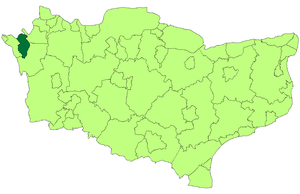Municipal Borough of Bromley
| Bromley | |
|---|---|
 Bromley within Kent in 1961 |
|
| Area | |
| • 1871 | 4,706 acres (19.04 km2) |
| • 1911 | 4,696 acres (19.00 km2) |
| • 1961 | 6,513 acres (26.36 km2) |
| Population | |
| • 1871 | 10,764 |
| • 1911 | 27,397 |
| • 1961 | 68,252 |
| Density | |
| • 1871 | 2.3/acre |
| • 1911 | 5.8/acre |
| • 1961 | 10.5/acre |
| History | |
| • Created | 1867 |
| • Abolished | 1965 |
| • Succeeded by | London Borough of Bromley |
| Status |
Local board (1867 - 1894) Urban district (1894 - 1903) Municipal borough (after 1903) |
| • HQ | Bromley |
| • Motto | Dum Cresco Spero (While I grow I hope) |
 Coat of arms |
|
Bromley was a local government district in northwest Kent from 1867 to 1965 around the town of Bromley. The area was suburban to London, and formed part of the Metropolitan Police District and from 1933 was included in the area of the London Passenger Transport Board.
Bromley Local Government District was formed in 1867 when the parish of Bromley adopted the Local Government Act 1858, and a local board of twelve members was formed to govern the town. The Local Government Act 1894 reconstituted the area as Bromley Urban District. An urban district council of 16 members replaced the local board.
The town was granted a charter of incorporation to become a municipal borough in 1903. The granting of the charter was celebrated by a public holiday in the town on 2 September 1903. The charter was brought by train to Bromley South station where it was handed to the charter mayor. The mayor then rode in procession led by units of the Royal Horse Artillery and the Royal West Kent Regiment, accompanied by mayors and mace bearers of boroughs in Kent and the County of London and watched by an estimated crowd of 20,000. A sports day and carnival was held at Queen's Mead.
Under the charter a town council consisting of a mayor, six aldermen and eighteen councillors replaced the UDC.
The area of the borough was increased in 1934, when a county review order added parts of the abolished Bromley Rural District (Hayes and part of Keston). The council was subsequently enlarged to seven aldermen and twenty-one councillors.
...
Wikipedia
